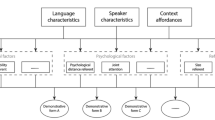Abstract
Generic noun phrases, or generics, refer to kinds (e.g., Birds lay eggs) rather than specific individuals (e.g., This bird lays eggs). Prior research with adults has indicated that adults are less likely to gesture in association with generic versus specific reference. In the current studies, we examined this phenomenon in children, comparing children’s gestures in scenarios of generic versus specific reference. Across two pragmatic contexts, three- to six-year-old children’s pointing was reduced during generic reference compared to specific reference. Results thus suggest that the tendency to reduce gestural marking for generics emerges early in development. We discuss these results within the context of a claim known as the “generics-as-default” proposal, which holds that reduced marking reflects that generics are basic and cognitively default.



Similar content being viewed by others
References
Bates, E., Benigni, L., Bretherton, I., Camaioni, L., & Volterra, V. (1979). The emergence of symbols: Cognition and communication in infancy. New York: Academic.
Cimpian, A., & Markman, E. M. (2008). Preschool children’s use of cues to generic meaning. Cognition, 107, 19–53.
Cimpian, A., & Markman, E. M. (2009). Information learned from generic language becomes central to children’s biological concepts: Evidence from their open-ended explanations. Cognition, 113, 14–25.
Cimpian, A., & Markman, E. M. (2011). The generic/nongeneric distinction influences how children interpret new information about social others. Child Development, 82, 471–492.
Cimpian, A., & Scott, R. M. (2012). Children expect generic knowledge to be widely shared. Cognition, 123, 419–433.
Desrochers, S., Morissette, P., & Ricard, M. (1995). Two perspectives on pointing in infancy. In C. Moore & P. J. Dunham (Eds.), Joint attention: Its origins and role in development (pp. 85–101). Hillsdale, NJ: Lawrence Erlbaum.
Gelman, S. A. (2003). The essential child: Origins of essentialism in everyday thought. London: Oxford University Press.
Gelman, S. A. (2004). Learning words for kinds: Generic noun phrases in acquisition. In D. G. Hall & S. R. Waxman (Eds.), Weaving a lexicon (pp. 445–484). Cambridge, MA: MIT Press.
Gelman, S. A., & Raman, L. (2003). Preschool children use linguistic form class and pragmatic cues to interpret generics. Child Development, 74, 308–325.
Gelman, S. A., Ware, E. A., Manczak, E. M., & Graham, S. A. (2013). Children’s sensitivity to the knowledge expressed in pedagogical and non-pedagogical contexts. Developmental Psychology, 49, 491–504.
Goldin-Meadow, S. (2003). Hearing gesture: How our hands help us think. Cambridge, MA: Harvard University Press.
Gullberg, M., De Bot, K., & Volterra, V. (2010). Gestures and some key issues in the study of language development. In M. Gullberg & K. De Bot (Eds.), Gestures in language development (pp. 3–33). Amsterdam: Benjamins.
Hollander, M. A., Gelman, S. A., & Raman, L. (2009). Generic language and judgments about category membership: Can generics highlight properties as central? Language and Cognitive Processes, 24, 481–505.
Iverson, J. M., Capirci, O., Volterra, V., & Goldin-Meadow, S. (2008). Learning to talk in a gesture-rich world: Early communication of Italian vs American children. First Language, 28, 164–181.
Leslie, S. J. (2008). Generics: Cognition and acquisition. Philosophical Review, 117, 1–47.
Liszkowski, U., Carpenter, M., & Tomasello, M. (2007). Pointing out new news, old news, and absent referents at 12 months of age. Developmental Science, 10, F1–F7.
Liszkowski, U., Schäfer, M., Carpenter, M., & Tomasello, M. (2009). Prelinguistic infants, but not chimpanzees, communicate about absent entities. Psychological Science, 20, 654–660.
Mannheim, B., Gelman, S. A., Escalante, C., Huayhua, M., & Puma, R. (2011). A developmental analysis of generic nouns in Southern Peruvian Quechua. Language Learning and Development, 7, 1–23.
McNeil, N., Alibali, M., & Evans, J. L. (2000). The role of gesture in children’s language comprehension: Now they need it, now they don’t. Journal of Nonverbal Behavior, 24, 131–150.
McNeill, D., Cassell, J., & Levy, E. T. (1993). Abstract deixis. Semiotica, 95, 5–20.
Meyer, M., & Baldwin, D. A. (2013). Pointing as a socio-pragmatic cue to particular vs. generic reference. Language Learning and Development, 9, 245–265.
Meyer, M., Gelman, S. A., & Stilwell, S. M. (2015). Frequency and informativeness of parents’ gestural cues associated with generic vs. particular reference. Language Learning and Development, 11, 285–309.
Pelletier, F. J. (2010). Generics: A philosophical introduction. In F. J. Pelletier (Ed.), Kinds, things, and stuff (pp. 3–15). New York: Oxford University Press.
Pettenati, P., Sekine, K., Congestrì, & Volterra, V. (2012). A comparative study on representational gesture in Italian and Japanese children. Journal of Nonverbal Behavior, 36, 149–164.
Rowe, M. L., Silverman, R., & Mullan, B. (2013). The role of pictures and gestures as nonverbal aids in preschoolers’ word learning in a novel language. Contemporary Educational Psychology, 38, 109–117.
Saylor, M. M., & Baldwin, D. A. (2004). Discussing those not present: Comprehension of references to absent caregivers. Journal of Child Language, 31, 537–560.
Stevanoni, E., & Salmon, K. (2005). Giving memory a hand: Instructing children to gesture enhances their event recall. Journal of Nonverbal Behavior, 29, 217–233.
Valenzeno, L., Alibali, M. W., & Klatzky, R. (2003). Teachers’ gestures facilitate students’ learning: A lesson in symmetry. Contemporary Educational Psychology, 28, 187–204.
Author information
Authors and Affiliations
Corresponding author
Rights and permissions
About this article
Cite this article
Meyer, M., Gelman, S.A. Generic Reference is Less Marked Than Specific Reference in Children’s Gestures. J Nonverbal Behav 40, 65–79 (2016). https://doi.org/10.1007/s10919-015-0220-x
Published:
Issue Date:
DOI: https://doi.org/10.1007/s10919-015-0220-x




